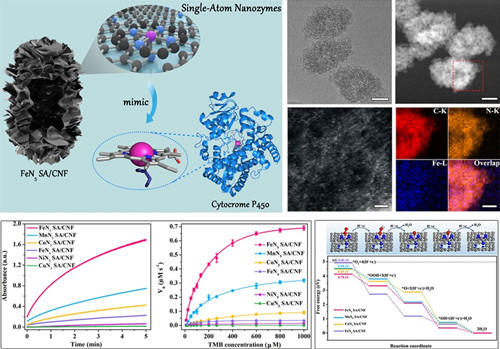To design and control the materials with natural enzyme characteristics has been a dream for scientists and engineers. Since the concept of nanozymes was put forward in 2013, more than 40 types of nanozymes have been developed with wide applications in biosensing, therapeutics and environmental protection. However, the low enzyme-like activities, especially the inhomogenous elemental composition and facet structure-derived intricate catalytic mechanisms, are formidable challenges facing nanozyme technologies. To meet these challenges, Prof. Shaojun Dong’s team discovered a class of single-atom nanozymes as promising next-generation nanozymes. The single-atom nanozymes with atomically dispersed and well-defined active sites embedded in nanomaterials significantly enhanced the catalytic activities and mechanism studies.
They synthesized single-atom nanozymes of carbon nanoframe confined axial N-coordinated FeN5 centers (FeN5 SA/CNF), theoretical calculations and experimental studies unambiguously identified that the highest oxidase-like activity of FeN5 SA/CNF was derived from the enzyme-like active sites and catalytic mechanisms. The present results suggested that the single-atom nanozymesovercame the critical drawbacks of conventional nanozymes, and mimicking the active sites of natural enzymes is an efficient method for the synthesis of single-atom nanozymes with high activity and clear mechanism. Furthermore, the catalytic property and the mechanism of single-atom nanozymes depend mainly upon the steric configuration of active centers, rather than the size, structure or facet of the supports. Thus through altering the supported nanomaterials, certain types of active sites can be extended to general applications with definite enzyme-like mechanism.
This work, published in Science Advances, https://advances.sciencemag.org/content/5/5/eaav5490.full.
Showed that the defined single-atom nanozymes provide a new perspective to the catalytic mechanism and rational design of nanozymes, and exhibit great potential to become the next-generation nanozymes.

Figure. Schematic illustration of atomically dispersed Fe sites mimicking the active center of Cytocrome P450, atomic structure characterization, as well as the experimental and theoretical investigation of oxidase-like activity of single-atom nanozymes. (Image by Dong Shaojun)
Contact:
DONG Shaojun
Email: dongsj@ciac.ac.cn
Changchun Institute of Applied Chemistry
Chinese Academy of Sciences
